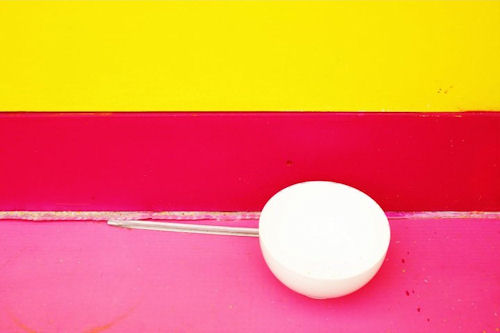 Desert Sunrise, 230B-4
Desert Sunrise, 230B-4
To mix Desert Sunrise 230B-4, combine equal parts vodka, orange juice, pineapple juice, and troposphere; add grenadine syrup to taste. Throw in blender with ice cubes and a handful of red dirt. Blend. Next drive westward all night along I-80 until you reach Wyoming, and, when you see in your rearview the faintest tincture of light bleeding into reddish bluffs, pull into the nearest rest stop. Wash your face in the frigid tap water, and next note the uncanniness of your reflection in the warped wrought-iron mirror. Stumble back to your pickup, and sit down on the hood with your back against the windshield. The morning air may still be cool, but the breeze will be warm, and the diesel-engine thrum of a parked semi nearby will lull you into a sequence of short naps, and each time you open your eyes the sky will open up gradually more, a budding flower in stop-motion. Repeat, until you feel suffused with a sublime Godlike loneliness.
Indian Paint Brush, 230B-5
To mix Indian Paint Brush 230B-5, first ascertain which species of the Castilleja genus (otherwise known as Indian Paint Brush) are indigenous to your area. For instance, in the Pacific Northwest where your family is from, there is a wide assortment: you’ll find the Wavyleaf and Cobwebby and Cream Sacs; the Cutleaf, Splitleaf and Splithair; the Coast, Cliff, Mountain, and Vernal Pool; the Wyoming, Wenatchee and Wallowa (also in both Pale and Yellow varieties); also, the Greentinge and the Golden, the Yellow and Stiff Yellow and Yellowhair, the Giant Red and Little Reddish; the Obscure and the Fraternal; the Northwestern and the Mendocino Coast; the Lesser and the Pale and the Attenuate; there are those named after people: of Chambers, of Cusick, those of Peck and Suksdorf and Thompson; there is Gland and Frosted, Sulphur and Sticky, Harsh and Hairy; there is Johnny-Nip and Parrothead. If you are in Alabama, however, there is only one variety: Scarlet. Next open up a map of Alabama and read aloud all the place names taken originally from the languages of the Native Americans who once lived here, names that once made the place sound so colorful before you moved here: Alabama, Autaga, Chattanoochee, Chickasaw, Choctaw, Chunchula, Conecuh, Coosa, Eutaw, Opelika, Selma, Syllacauga, Talladega, Tallapoosa, Tuscaloosa, Tuskegee, and so forth. Become sidetracked in your thoughts and imagine that in some alternate and kinder history of the world the tribes and nations of Alabama weren’t forcefully evicted westward, but just wandered off one day in search of brighter color, with Old Hickory Jackson himself riding out on horseback to the head of the procession, pleading for them to return.
Orange Burst, 230B-6
To mix Orange Burst 230B-6, travel to some hot eastern nation and order a can of cold Fanta in a shady outdoor cafe looking out onto a hot and bustling street. Though you never drink Fanta at home, in this foreign place it will be the best thing you ever tasted. Then, while you sit there, write about this Fanta in a letter home you will never end up posting.
Kumquat, 230B-7
To mix Kumquat 230B-7, first grow a kumquat tree. You may find it helpful to observe your neighbor’s tree, which grows along the chain-link fence adjacent to your driveway. In the fall, furtively pluck off one of these sour fruits every few days. Grimace as you chew. Think, Look at me: I’m eating a kumquat. Your neighbor from Mobile will have transplanted this tree northward the previous spring, and won’t know how it will fare in the relatively cooler climate of central Alabama. Next, wait until January, when a weather system locals assure you is abnormal brings several weeks of below-freezing nights, and in the evenings listen to the rustle of your neighbor covering the tree with blue tarpaulin. When the cold fails to let up after a few days, wake up one morning and observe the tarpaulin lit up from underneath with a gauzy array of colored Christmas lights, each roughly the size of a plump kumquat, presumably to provide warmth. This will fail to keep the plant alive. Months later, in the spring, take note of the little gelatinous blanched orbs that still litter your driveway, milky-white as the skin of fat that settles at the top of a chilled stew.
—
David Andrews currently lives in Tuscaloosa, Alabama, with his wife, and attends the University of Alabama’s MFA program. He’s from several different places, but for present purposes self-identifies as a Midwesterner, because it’s just easier that way.
Photo by Tory M. Taylor
